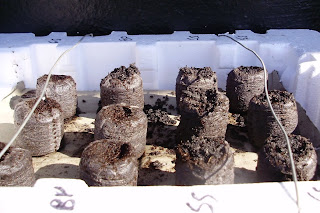Part of our 2011 sustainable living goals to reduce how much our household puts into general waste each week.
In order to reduce your waste, you need to know what is going into your bin each week. We decided to go bin by bin in our house to see what we were regularly throwing into general waste and what changes we could make to replace these things with recyclable or reusable options where possible or otherwise reduce the amount wasted.
The Bathroom
The bathroom can be a challenging area to reduce waste without compromising health and hygiene.
What we've already done
Some easy steps we'd already taken to reduce waste in the bathroom include:
- selecting products in recyclable containers
- choosing recycled toilet paper that comes in paper wrapping rather than plastic wrap
- looking for products that use containers made from recycled materials
A couple of years ago I swapped disposable razors and wax strips for a rechargeable epilator. A bit of an upfront cost, but it has paid itself off in both money and waste compared to shaving or waxing (though depending on your pain threshold, you may need to factor in a few bottles of gin to the costs...)
What we've done this year
If you live in a household with females, you've probably noticed that once a month the bathroom waste increases. Our bin audit revealed that feminine hygiene products accounted for a significant amount of our bathroom waste. This year I decided to look for more sustainable options to reduce the amount of waste. The options I found were:
- compostable tampons and pads
- fabric reusable pads
- silicone or rubber menstrual cups
The first option didn't really appeal as I was dubious as to how effective our compost bin would be in breaking down the used products quickly and as we use our compost on our vegie garden, I didn't want to risk any nasty bugs. The fabric reusable pads didn't appeal to me either as I don't like conventional pads. However, I did buy a soft bamboo reusable pad to give it a go. I didn't like it. Too bulky, soft but still uncomfortable to wear and I was constantly worried about it moving around or leaking. That left the menstrual cups. I had heard about them before, via blogs of friends, and always thought them a little on the "crusty" side of hippidom. However I did think they were worth a shot so at the beginning of this year I ordered a
Lunette cup online.
I have to say I'm a complete convert! Seriously, I wish I'd known more about these years ago. I found the cup very easy to use, comfortable, completely secure, easy to clean and best of all, no waste going into the bin! It's a triple win in that it a) reduced regular costs, b) is more comfortable and convenient than previous methods, and c) is almost waste free. You can add an extra bonus in there if you consider that by having a reusable option always ready you eliminate the need to send confused male partners into the supermarket for emergencies. There is an upfront cost in that they are ~$57.00 (AUD), but considering they will last 5-10 years with correct care, that's pretty cheap compared to how much you'd spend on conventional products over that same time period.
Further information for those who are interested (and ladies, I strongly recommend giving these a try, they are honestly no more "icky" than using conventional products):
- Lunette website - http://www.lunette.com.au/. There are other brands of cups out there, but this was the one I decided to try based on reviews and availability and I've been really happy with it. I think it is one of the few that has been approved for sale in Australia (The TGA happily lets shonky homeopathic crap into pharmacies, but getting a menstrual cup approved is apparently quite difficult)
- This website has lots of useful information about menstrual cups, including brand comparisons and FAQs - http://labyrinth.net.au/~obsidian/clothpads/Cups.html
- The livejournal community forum on menstrual cups - http://menstrual-cups.livejournal.com/
What's left that we haven't been able to reduce
We still have a number of things that end up in the bathroom bin regularly that we haven't been able to replace or reduce.
- The CPD's disposable razor cartridges. The most sustainable option would be not to shave, but the bearded look isn't great so it will be razors for a while yet.
- Dental floss. The CPD bought a Waterpik water flosser when he got braces, which uses a fine jet of water to floss around teeth and braces. I still use regular floss though as I find the machine a bit awkward.
- Products that come in non-recyclable containers like toothpaste and some cosmetics.
- Cotton buds and cotton wool. We try to use ethically sourced options, but they are still disposable.
However, the overall volume of bathroom waste has probably been reduced by at least 50% simply from changing my feminine hygiene practices. We have a tiny bin in the bathroom and it rarely has more than a handful of rubbish each week so on the whole I'm pretty happy with how we're going in this area.






































